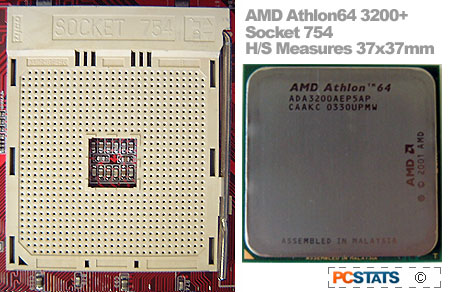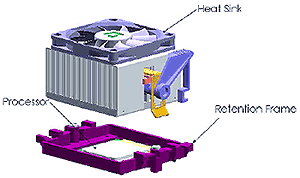With
the release of the Athlon64 3200+ we are finally saying good by to the venerable
Socket 462/A platform. AthlonXP 3200's and Athlon64 3200's may only differ in
name slightly, but the physical changes are enormous. To accommodate the nearly
106 million transistors packed into a 193mm2 die on the Athlon 64 3200+
processor, and the roughly 80W heat output, AMD have migrated to an entirely new
cooling platform.

Gone are
the difficult to engage spring clips that could rip out the very catches they
were supposed to clip into along the side of the socket. Gone are the problems
with nearby electrolytic capacitors blocking us from installing large heatsinks.
Gone are the problems with chipped silicon cores because the heatsink was
installed at an angle improperly. Gone are the 4-second nuclear
meltdowns of an Athlon's core thanks to a heatsink that was only riding on
the silicon's very edge. Gone is the need for shims, the best of which kept the
core from being chipped, and the worst of which shorted out ceramic capacitors,
or actually elevated the heatsink above the silicon a few mils.  Gone are
worries of Arctic Silver's conductive thermal compound voiding an AthlonXP's
warranty, or worse, shorting out the processor. Gone are the problems of
excessively stiff heatsink mounting clips or mechanisms that applied so much
force the processor actually cracked and split in two. Gone is the frustration
of having spent $70 on a high performance copper heatsink that uses the four
mounting holes in the PCB to attach itself when your brand new motherboard no
longer comes with them.
Gone are
worries of Arctic Silver's conductive thermal compound voiding an AthlonXP's
warranty, or worse, shorting out the processor. Gone are the problems of
excessively stiff heatsink mounting clips or mechanisms that applied so much
force the processor actually cracked and split in two. Gone is the frustration
of having spent $70 on a high performance copper heatsink that uses the four
mounting holes in the PCB to attach itself when your brand new motherboard no
longer comes with them.
Yup. Gone
is Socket A, and all of its problems with it!
The
Athlon64 produces upwards of an 80W heat load, and to maintain operational
temperatures at a reasonable noise level, AMD have had to rethink things. Larger
heatsinks tend to be more efficient because of larger surface areas, and it also
helps to use 70mm fans.
The catch
is that along with a larger heatsink, weight becomes an issue. Keeping that
metal mass over the processor stable used to fall to the socket itself, and to
combat the frightening thought of a chunk of metal rattling around in case, AMD
now use a retention frame.
